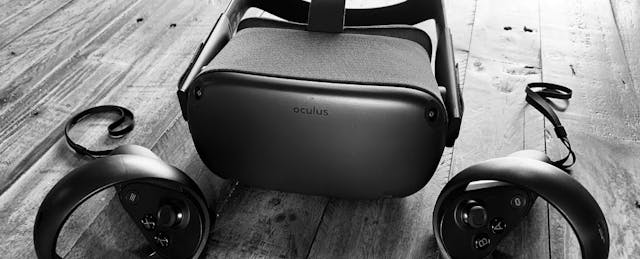There’s been quite a bit of anticipation leading up to the release of the Oculus Quest—the latest virtual reality headset from the Facebook-owned Oculus.
Thankfully, the Quest is finally available for purchase after a long wait! Many early adopters like myself made a jump to the Oculus Go in the past year with enthusiasm, believing the stand-alone device could provide a deeper virtual reality experience—no wires connected to a computer, and no cameras to set up in the room—just hop on and get started.
When the Oculus Go was first released, the educational apps were limited. I didn’t see a need to promote the device for classrooms from the beginning, but we’ve seen many more educational apps flooding the Oculus Experiences market (which is sort of like an app store for the platform) that made the headset more valuable for classroom lessons. I believe the same will be true for the Quest.
The Oculus Quest is mainly being marketed as an all-in-one VR gaming system, but I see much potential for classroom lessons. A key feature allows our students the freedom to safely walk around while exploring and interacting in virtual reality. The Oculus Go delivered a VR view, but the Oculus Quest provides us with interactions.
One major difference between the Quest and the Go is the lack of motion sickness with the new device. If I spent any time on apps with quite a bit of movement while using the Go, I would get sick to my stomach. Yet I’ve spent several hours on the Quest since its release in a variety of apps without any illness whatsoever. The resolution is slightly better in the Quest, but the difference provides a much better overall experience.
The Quest is boasting technology that’s perfect for the classroom, but keep in mind the starting age is listed at 13, according to Oculus. The connection via Wi-Fi makes the device easy to hop on and enjoy immediately. The dual hand controllers allow students to perform actions that were limited by the Go for realistic experiences and precision. The 6 degrees of freedom (6DoF) provides mobility for the student to walk forward, backward, left, right, jump up and squat down. In other words, they can move around just like they would in real life.
The new Guardian technology keeps your students safe by deterring them from obstacles in your physical space, so they don’t walk into desks or chairs. Students can identify and mark their boundaries so they can fully explore without the worry of colliding with a desk. The option for stationary play, similar to the Oculus Go, is also available.
The affordable starting price of $399 for 64 GB is comparable to other classroom devices, such as Chromebooks, laptops and iPads. If you purchase a single device and you plan to download many experiences, I’d recommend requesting the $499 device with 128 GB of storage. One significant difference I’ve found so far between the Quest and the Go is the high cost of the apps. By contrast, the majority of my Oculus Go apps were free.
Another new Quest feature I really appreciate is the eyeglass spacer provided in the box. Students who wear glasses now have the option to add the spacer to the device to provide the space needed to wear glasses while in VR. One common complaint from educators about VR headsets is that they aren’t always accessible for all our students. I’m thankful that Oculus has put accessibility as a priority in their product.
Oculus also added a few additional features to add convenience for the classroom, including mirroring your Quest experience and a long power cord. Sharing your VR view to a mobile device can bring in many more students to watch and participate—meaning it’s not such a solo experience. Most educators won’t have multiple Quest devices available, so the streaming option helps maximize the benefit of the headset. The long charging cord is an added bonus because using the headset in lessons often drains the battery quickly. The opportunity to charge while using the Quest continues the learning without interruption.
Now let’s get to the fun stuff. Here are a handful of Oculus Quest apps available today that are worth considering.
Tilt Brush ($19.99)

You read that right! The Google Tilt Brush app was one of the huge selling points for the HTC Vive in the classroom and is now available on the Quest. There is no doubt that student creation is one of the most important reasons for districts to make immersive technology purchases. The Tilt Brush app changes the way we’ve always drawn by jumping into a 360-degree space and drawing 3D objects in virtual reality. (Video)
Ocean Rift ($9.99)

I tried the Ocean Rift for the time, and I was incredibly impressed with the ocean experiences. Not only did I dive into deep sea swimming, but I discovered amazing creatures and swam alongside them. You will not be disappointed with the Ocean Rift app. (Video)
National Geographic Explore VR ($9.99)

If you’d like to bring your students to the most extreme places around the world, then look no further because the National Geographic app will provide breathtaking adventures. From snowstorms to kayaking, your students will survive the harshest conditions while exploring the world.
Nature Treks VR ($9.99)

Do you need a mini vacation? When it comes to mindfulness, Nature Treks VR has provided a calming experience. Redesign your VR space by dragging tropical elements into your scene. Each environment is a relaxing world adjustable to your preference. From day to night, to sun or rain, the environment changes to your liking. Get out your sunscreen and enjoy! (Video)
The educational list of apps is short just as we found in the Oculus Go at the beginning, but many app developers are pushing to include their products on this new device, such as the rumored frog dissection app from VictoryXR. And I anticipate some of the same Go and Rift apps will eventually make its way into the Quest market. But even still, as we wait for more content, it’s a good idea to add the Oculus Quest to your wish list for the 2019-20 classroom budgets.


